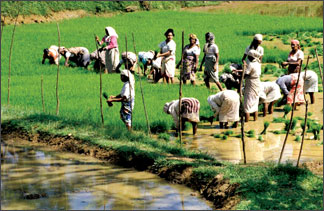Agriculture - the best investment
by Lalin Fernandopulle
[email protected]
The time is ideal for Sri Lanka to gain maximum benefits by investing
in agriculture since global food prices are surging due to the severe
shortage of production of grains, said Managing Director CIC
Agribusinesses, Keerthi Kotagama.
 He said the country is blessed with fertile soil, sufficient rainfall
and the expertise in traditional farming which will be of immense use to
develop the agriculture sector. He said the country is blessed with fertile soil, sufficient rainfall
and the expertise in traditional farming which will be of immense use to
develop the agriculture sector.
“The company will invest Rs. 250 million shortly on a project to
produce around 5,000 litres of milk per day on a 1,200 acre farm in the
Eastern province”, Kotagama said.
He said the company invested Rs. 30 million on a project to produce
15,000 MT of maize with over 7,500 outgrower farmers in Thalawa. CIC
Agribusiness invested on a rice mill in Maho to produce 6,000mt of paddy
with 2,000 farmers in the North Central province.
The global food crisis is posing a potential threat to poorer
countries in the South East Asian region and the African regions. The
consumption boom in India and China together with the transition from
grain production to bio-fuel in many countries and the food shortage
will aggravate putting an end to the cheap food era in 20-30 years.
Many countries have realised that ethanol is economically feasible
when world crude oil prices have shot above US$ 124 per barrel. Brazil,
Argentina and USA have turned vast extents of grain cultivation land to
manufacture ethanol.
Global bio fuel production tripled from 18 billion litres in 2000 to
60 billion litres last year.The EU targets 5 per cent replacement of
crude oil with ethanol by 2010.
Kotagama said there is no problem in marketing paddy today as the
demand has increased. Investments in grain cultivation will be a saving
for the country which depends heavily on wheat and other grain imports.
The country produces 3.3 million mt of paddy per annum while the
requirement of rice is 2.3 million mt which is equal to 3.8 million mt
of paddy. The country’s per capita consumption of rice per annum is 115
kilograms.
“The shortfall in paddy can be met by increasing the yield and the
land extent. If the paddy yield is increased by 20 per cent per annum
the country could produce around 4.4 million mt which is above the
national requirement”, he said.
The agriculture and milk industry will reap benefits within a year if
the land in the East is used to cultivate paddy and graze cattle. The
current production of milk is around 200 million litres a year while the
requirement is 900 million litres. |
